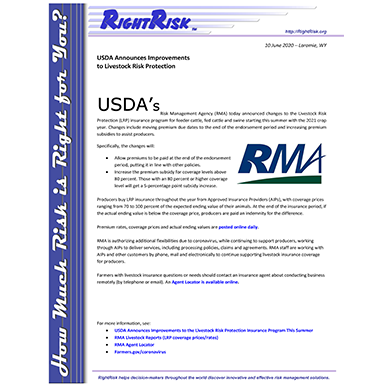USDA’s Risk Management Agency (RMA) today announced changes to the Livestock Risk Protection (LRP) insurance program for feeder cattle, fed cattle and swine starting this summer with the 2021 crop year. Changes include moving premium due dates to the end of the endorsement period and increasing premium subsidies to assist producers.
Category Archives: RightRisk News Release
Ag Businesses have Special Window for EID Loans
The Small Business Administration is now accepting new Economic Injury Disaster Loan (EIDL) applications by agricultural businesses only. The EIDL Program can provide up to $2 million of financial assistance to eligible businesses and private, non-profit organizations that suffer substantial economic injury as a result of a declared disaster. It provides relief from economic injury caused directly by the disaster and permits a successful applicant to maintain a reasonable working capital position during the period affected by the disaster.
Assistance for Producers Affected by Meat Processing Plant Closures
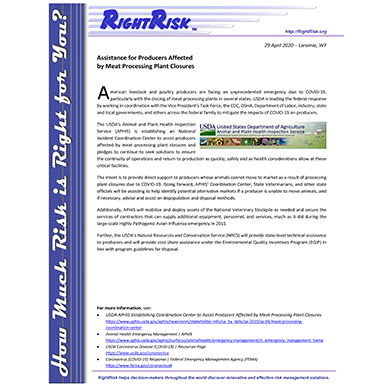
The USDA’s Animal and Plant Health Inspection Service (APHIS) is establishing an National Incident Coordination Center to assist producers affected by meat processing plant closures and pledges to continue to seek solutions to ensure the continuity of operations and return to production as quickly, safely and as health considerations allow at these critical facilities.
Interim Final Rule on Business Loan Program Temporary Changes; Paycheck Protection Program
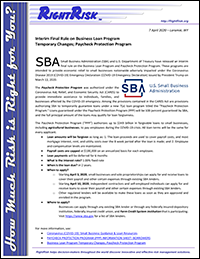
USDA Small Business Administration (SBA) and U.S. Department of Treasury have released an interim final rule on the Business Loan Program and Paycheck Protection Program. These programs are intended to provide economic relief to small businesses nationwide adversely impacted under the Coronavirus Disease 2019 (COVID-19) Emergency Declaration (COVID-19 Emergency Declaration) issued by President Trump on March 13, 2020.
FSA Makes Changes to Farm Loan, Disaster, Conservation and Safety Net Programs to Make it Easier for Customers to Conduct Business
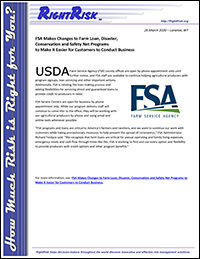
USDA Farm Service Agency (FSA) county offices are open by phone appointment only until further notice, and FSA staff are available to continue helping agricultural producers with program signups, loan servicing and other important actions. Additionally, FSA is relaxing the loan-making process and adding flexibilities for servicing direct and guaranteed loans to provide credit to producers in need.
Report: Farmers Prevented from Planting Crops on More than 19 Million Acres
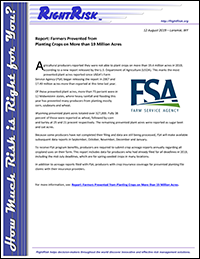
Aricultural producers reported they were not able to plant crops on more than 19.4 million acres in 2019, according to a new report released by the U.S. Department of Agriculture (USDA). This marks the most prevented plant acres reported since USDA’s Farm Service Agency (FSA) began releasing the report in 2007 and 17.49 million acres more than reported at this time last year.
Managing Forage Production Risk in the Western States: The Role of PRF Rainfall Index Insurance
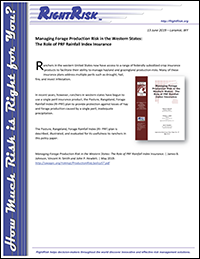
Ranchers in the western United States now have access to a range of federally subsidized crop insurance products to facilitate their ability to manage hayland and grazingland production risks. Many of these insurance plans address multiple perils such as drought, hail, fire, and insect infestation.
In recent years, however, ranchers in western states have begun to use a single peril insurance product, the Pasture, Rangeland, Forage Rainfall Index (RI‐PRF) plan to provide protection against losses of hay and forage production caused by a single peril, inadequate precipitation.
The Pasture, Rangeland, Forage Rainfall Index (RI‐ PRF) plan is described, illustrated, and evaluated for its usefulness to ranchers in this policy paper.
Managing Price Risk through the Livestock Risk Protection Insurance Plan in the Western United States
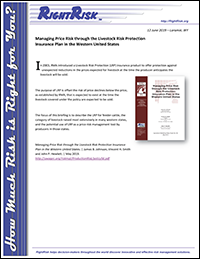
In 2003, RMA introduced a Livestock Risk Protection (LRP) insurance product to offer protection against unexpected reductions in the prices expected for livestock at the time the producer anticipates the livestock will be sold.
The purpose of LRP is offset the risk of price declines below the price, as established by RMA, that is expected to exist at the time the livestock covered under the policy are expected to be sold.
The focus of this briefing is to describe the LRP for feeder cattle, the category of livestock raised most extensively in many western states, and the potential use of LRP as a price risk management tool by producers in those states.
Federal Reserve Beige Book Summary on the Ag Sector in Western States
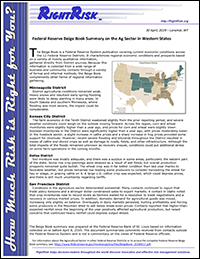
The Beige Book is a Federal Reserve System publication about current economic conditions across the 12 Federal Reserve Districts. It characterizes regional economic conditions and prospects based on a variety of mostly qualitative information, gathered directly from District sources.
The most recent Beige Book provides a brief summary of the Agriculture Sector in Western States.
RightRisk Featured on ABC TAS Country Hour
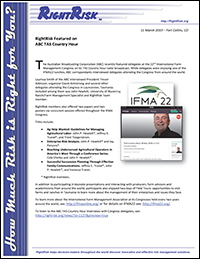
The Australian Broadcasting Corporation (ABC) recently featured delegates at the 22nd International Farm Management Congress on its TAS Country Hour radio broaadcast. While delegates were enjoying one of the IFMA22 lunches, ABC corrispondants interviewed delegates attending the Congress from around the world.
Laurissa Smith of the ABC interviewed President Trevor Atkinson, organizor David Armstrong and several other delegates attending the Congress in Launceston, Tasmania. Included among them was John Hewlett, University of Wyoming Ranch/Farm Management Specialist and RightRisk Team member.
![]() Click here to listen to the ABC TAS Country Hour online.
Click here to listen to the ABC TAS Country Hour online.
![]() Click here to download the ABC TAS Country Hour broadcast in MP3 format.
Click here to download the ABC TAS Country Hour broadcast in MP3 format.
